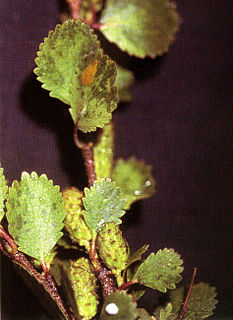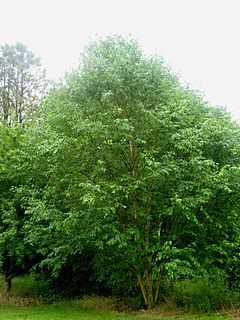
Betula pendula, commonly known as silver birch, warty birch, European white birch, or East Asian white birch, is a species of tree in the family Betulaceae, native to Europe and parts of Asia, though in southern Europe, it is only found at higher altitudes. Its range extends into Siberia, China, and southwest Asia in the mountains of northern Turkey, the Caucasus, and northern Iran. It has been introduced into North America, where it is known as the European white birch or weeping birch and is considered invasive in some states in the United States and parts of Canada. The tree can also be found in more temperate regions of Australia.

Betula pubescens, commonly known as downy birch and also as moor birch, white birch, European white birch or hairy birch, is a species of deciduous tree, native and abundant throughout northern Europe and northern Asia, growing farther north than any other broadleaf tree. It is closely related to, and often confused with, the silver birch, but grows in wetter places with heavier soils and poorer drainage; smaller trees can also be confused with the dwarf birch.

Betula papyrifera is a short-lived species of birch native to northern North America. Paper birch is named for the tree's thin white bark, which often peels in paper like layers from the trunk. Paper birch is often one of the first species to colonize a burned area within the northern latitudes, and is an important species for moose browsing. The wood is often used for pulpwood and firewood.

Betula nana, the dwarf birch, is a species of birch in the family Betulaceae, found mainly in the tundra of the Arctic region.

Betula populifolia is a deciduous tree native to eastern North America.

The gray treefrog is a species of small arboreal holarctic tree frog native to much of the eastern United States and southeastern Canada.

Betula pumila is a deciduous shrub native to North America. Bog birch occurs over a vast area of northern North America, from Yukon in the west to New England in the east and all the way to Washington and Oregon, inhabiting swamps and riparian zones in the boreal forests.

The mourning wheatear is a bird, one of 14 species of wheatear found in northern Africa and the Middle East. It is a small passerine in a group formerly classed as members of the thrush family Turdidae, but now more generally considered to be part of the Old World flycatcher family Muscicapidae.

The plains viscacha rat, plains vizcacha rat, red viscacha rat, or red vizcacha rat is a species of rodent in the family Octodontidae native to Argentina. It is one of three species in the genus Tympanoctomys.

Betula uber, Virginia round-leaf birch, is a rare species of tree in the birch family. One of the most endangered species of North American trees, it is endemic to Smyth County, in the U.S. state of Virginia. It is part of the temperate broadleaf and mixed forests biome.

Betula cordifolia, the mountain paper birch is a birch species native to Eastern Canada and the Northeastern United States. Until recently it was considered a variety of Betula papyrifera, with which it shares many characteristics, and it was classified as B. papyrifera var. cordifolia (Regel) Fern.

Betula humilis, known in English as the shrubby birch, is a species of birch that can be found in Europe and Asia. The species has ovate leaves that are 1.2–3.5 centimetres (0.47–1.38 in) long and is related to Betula fruticosa.

Betula chinensis, commonly known as dwarf small-leaf birch, is a species of birch that can be found in China and Korea on the elevation of 700–3,000 metres (2,300–9,800 ft).
Halophila baillonis is a species of aquatic plant in the family Hydrocharitaceae. It is referred to by the common name clover grass. It is native to Brazil, Cayman Islands, Colombia, Costa Rica, Jamaica, Leeward Islands, Netherlands Antilles, Panama, Puerto Rico, Trinidad and Tobago, and Venezuela. It is listed on the IUCN Red List as "vulnerable" due to its naturally rare occurrence and fragmented populations.

Halophila stipulacea is a species of seagrass in the Hydrocharitaceae family. It is native to the Indian Ocean that spread into the Mediterranean after the opening of the Suez Canal. This seagrass is widespread through the Gulf of Aqaba. Recently it has arrived in the Caribbean where it is also spreading.

Betula grossa, commonly known as Japanese cherry birch, is a species of birch native to Japan, where it grows naturally in mixed woodland on hill and mountain slopes in Honshu, Shikoku, and Kyushu. It was introduced to the West in 1896, but remains rare in cultivation.

Betula chichibuensis, commonly known as Chichibu birch, is a species of birch native exclusively to limestone outcrops in the Okuchichibu and Kitakami Mountains of central and northeast Honshu, Japan. The tree is rated as Critically Endangered on the IUCN Red List due to its extreme rarity and limited range.
















